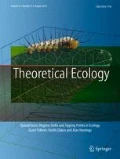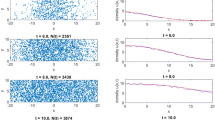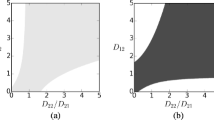Abstract
Understanding the factors that influence successful colonization can help inform ecological theory and aid in the management of invasive species. When founder populations are small, individual fitness may be negatively impacted by component Allee effects through positive density dependence (e.g., mate limitation). Reproductive and survival mechanisms that suffer due to a shortage of conspecifics may scale up to be manifest in a decreased per-capita population growth rate (i.e., a demographic Allee effect). Mean-field population level models are limited in representing how component Allee effects scale up to demographic Allee effects when heterogeneous spatial structure influences conspecific availability. Thus, such models may not adequately characterize the probability of establishment. In order to better assess how individual level processes influence population establishment and spread, we developed a spatially explicit individual-based stochastic simulation of a small founder population. We found that increased aggregation can affect individual fitness and subsequently impact population growth; however, relatively slow dispersal—in addition to initial spatial structure—is required for establishment, ultimately creating a tradeoff between probability of initial establishment and rate of subsequent spread. Since this result is sensitive to the scaling up of component Allee effects, details of individual dispersal and interaction kernels are key factors influencing population level processes. Overall, we demonstrate the importance of considering both spatial structure and individual level traits in assessing the consequences of Allee effects in biological invasions.




Similar content being viewed by others
References
Ackleh AS, Allen LJS, Carter J (2007) Establishing a beachhead: a stochastic population model with an Allee effect applied to species invasion. Theor Popul Biol 71:290–300
Allee WC (1931) Animal aggregations, a study in general sociology. University of Chicago Press, Chicago
Berec L, Boukal DS, Berec M (2001) Linking the Allee effect, sexual reproduction, and temperature-dependent sex determination via spatial dynamics. Am Nat 157:217–230
Berec L, Angulo E, Courchamp F (2007) Multiple Allee effects and population management. Trends Ecol Evol 22:185–191
Birch DA, Young WR (2006) A master equation for a spatial population model with pair interactions. Theor Popul Biol 70:26–42
Bolker B, Pacala SW (1997) Using moment equations to understand stochastically driven spatial pattern formation in ecological systems. Theor Popul Biol 52:179–197
Courchamp F, Berec L, Gascoigne J (2008) Allee effects in ecology and conservation: Oxford biology. Oxford University Press, Oxford
Dixon PM (2002) Ripley’s K function. Encyclopedia Environ 3:1796–1803
Drake JM, Lodge DM, Lewis M (2005) Theory and preliminary analysis of species invasions from ballast water: controlling discharge volume and location. Am Mid Nat 154:459–470
Drury KLS, Drake JM, Lodge DM, Dwyer G (2007) Immigration events dispersed in space and time: factors affecting invasion success. Ecol Model 206:63–78
Durrett R, Levin S (1994) The importance of being discrete (and spatial). Theor Popul Biol 46:363–394
Erban R, Chapman S, Maini P (2007) A practical guide to stochastic simulations of reaction-diffusion processes. http://arxiv.org0704.1908
Fortin M-J, Dale MRT (2005) Spatial analysis: a guide for ecologists. Cambridge University Press, Cambridge
Gascoigne J, Berec L, Gregory S, Courchamp F (2009) Dangerously few liaisons: a review of mate-finding Allee effects. Popul Ecol 51:355–372
Gillespie DT (1977) Exact stochastic simulation of coupled chemical reactions. J Phys Chem 81:2340–2361
Grindrod P (1988) Models of individual aggregation or clustering in single and multi-species communities. J Math Biol 26:651–660
Hengeveld R, Hemerik L (2002) Biogeography and dispersal. In: Bullock JM, Kenward RE, Hails RS (eds) Dispersal ecology. Blackwell, Oxford, pp 303–326
Holt RD, Knight TM, Barfield M (2004) Allee effects, immigration, and the evolution of species’ niches. Am Nat 163:253–262
Johnson DM, Liebhold AM, Tobin PC, Bjornstad ON (2006) Allee effects and pulsed invasion by the gypsy moth. Nature 444:361–363
Kanarek AR, Webb CT (2010) Allee effects, adaptive evolution, and invasion success. Evol Appl 3:122–135
Keitt TH, Lewis MA, Holt RD (2001) Allee effects, invasion pinning, and species’ borders. Am Nat 157:203–216
Kierstead H, Slobodkin LB (1953) The size of water masses containing plankton blooms. J Mar Res 12:141–147
Kot M (2001) Elements of mathematical ecology. Cambridge University Press, Cambridge
Law R, Murrell DJ, Dieckmann U (2003) Population growth in space and time: spatial logistic equations. Ecology 84:252–262
Lewis MA, Kareiva P (1993) Allee dynamics and the spread of invading organisms. Theor Popul Biol 43:141–158
Lockwood JL, Cassey P, Blackburn T (2005) The role of propagule pressure in explaining species invasions. Trends Ecol Evol 20:223–228
Lockwood JL, Hoopes MF, Marchetti MP (2007) Invasion ecology. Blackwell, Malden
Murray JD (1993) Mathematical biology: biomathematics. Springer, Berlin
Murrell DJ (2006) Local interactions and invasion dynamics: population growth in space and time. In: Cadotte MW, McMahon S, Fukami T (eds) Conceptual ecology and invasion biology: reciprocal approaches to nature. Springer, Netherlands, pp 147–168
Okubo A (1980) Diffusion and ecological problems: mathematical models: Biomathematics 10. Springer, Berlin
Padron V, Trevisan MC (2000) Effect of aggregating behavior on population recovery on a set of habitat islands. Math Biosci 165:63–78
R Development Core Team (2009) R: a language and environment for statistical computing. R Foundation for Statistical Computing, Vienna, Austria. ISBN 3-900051-07-0, URL http://www.R-project.org
Renshaw E (1991) Modelling biological populations in space and time: Cambridge studies in mathematical biology. Cambridge University Press, Cambridge
Ripley BD (1976) The second-order analysis of stationary point processes. J Appl Probab 13:255–266
Robinet C, Liebhold AM (2009) Dispersal polymorphism in an invasive forest pest affects its ability to establish. Ecol Appl 19:1935–1943
Simberloff D (2009) The role of propagule pressure in biological invasions. Annu Rev Ecol Evol Syst 40:81–102
Skellam JG (1951) Random dispersal in theoretical populations. Biometrika 38:196–218
Stephens PA, Sutherland WJ (1999) Consequences of the Allee effect for behaviour, ecology and conservation. Trends Ecol Evol 14:401–405
Stephens PA, Sutherland WJ, Freckleton RP (1999) What is the Allee effect? Oikos 87:185–190
Stewart-Cox JA, Britton NF, Mogie M (2005) Pollen limitation or mate search need not induce an Allee effect. B Math Biol 67:1049–1079
Taylor CM, Hastings A (2005) Allee effects in biological invasions. Ecol Lett 8:895–908
Tobin PC, Whitmire SL, Johnson DM, Bjornstad ON, Liebhold AM (2007) Invasion speed is affected by geographical variation in the strength of Allee effects. Ecol Lett 10:36–43
Twomey A (2007) On the stochastic modelling of reaction-diffusion processes. Masters thesis, University of Oxford
Vercken E, Kramer AM, Tobin PC, Drake JM (2011) Critical patch size generated by Allee effect in gypsy moth, Lymantria dispar (L.). Ecol Lett 14:179–186
Williamson M (1996) Biological invasions. Chapman and Hall, London
Acknowledgments
We would like to thank Michael Buhnerkempe and the rest of the Webb Lab, Dan Ryan, Ben Bolker, Greg Dwyer, and three anonymous reviewers for helpful comments and advice. ARK acknowledges funding from NSF-IGERT Grant DGE-#0221595 administered by PRIMES at CSU, travel grants from the Global Invasions Network NSF-RCN DEB-#0541673 for facilitating this collaboration, and by the National Institute for Mathematical and Biological Synthesis, an Institute sponsored by NSF, the U.S. Department of Homeland Security, and the US Department of Agriculture through NSF Award #EF-0832858, with additional support from The University of Tennessee, Knoxville. RDH and MB thank the University of Florida Foundation for support.
Author information
Authors and Affiliations
Corresponding author
Rights and permissions
About this article
Cite this article
Kanarek, A.R., Webb, C.T., Barfield, M. et al. Allee effects, aggregation, and invasion success. Theor Ecol 6, 153–164 (2013). https://doi.org/10.1007/s12080-012-0167-z
Received:
Accepted:
Published:
Issue Date:
DOI: https://doi.org/10.1007/s12080-012-0167-z




